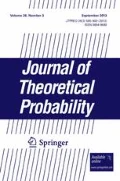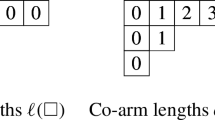Abstract
For a natural extension of the circular unitary ensemble of order n, we study as \(n\rightarrow \infty \) the asymptotic behavior of the sequence of monic orthogonal polynomials \((\varPhi _{k,n}, k=0, \ldots , n)\) with respect to the spectral measure associated with a fixed vector, the last term being the characteristic polynomial. We show that, as \(n\rightarrow \infty \), the sequence of processes \((\log \varPhi _{\lfloor nt\rfloor ,n}(1), t \in [0,1])\) converges to a deterministic limit, and we describe the fluctuations and the large deviations.
Similar content being viewed by others
Notes
By a slight abuse of language, “ensemble” will mean such a distribution.
References
Abramowitz, M., Stegun, I.A.: Handbook of Mathematical Functions with Formulas, Graphs, and Mathematical Tables, 9th edn, pp. 258–259. Dover, New York (1972)
Borot, G., Guionnet, A.: Asymptotic expansion of \(\beta \) matrix models in the one-cut regime. Comm. Math. Phys. 317(2), 447–483 (2013)
Bourgade, P., Hughes, C.P., Nikeghbali, A., Yor, M.: The characteristic polynomial of a random unitary matrix: a probabilistic approach. Duke Math. J. 145(1), 45–69 (2008)
Bourgade, P., Nikeghbali, A., Rouault, A.: The characteristic polynomial on compact groups with Haar measure: some equalities in law. C. R. Math. Acad. Sci. Paris 345(4), 229–232 (2007)
Bourgade, P., Nikeghbali, A., Rouault, A.: Circular Jacobi ensembles and deformed Verblunsky coefficients. Int. Math. Res. Not. IMRN 23, 4357–4394 (2009)
Bourgade, P., Nikeghbali, A., Rouault, A.: Ewens Measures on Compact Groups and Hypergeometric Kernels. In: Séminaire de probabilités XLIII, volume 2006 of Lecture Notes in Mathematics, pp. 351–378. Springer, Berlin (2010)
Dembo, A., Zeitouni, O.: Large Deviations Techniques and Applications, 2nd edn. Springer, Berlin (1998)
Dette, H., Gamboa, F.: Asymptotic properties of the algebraic moment range process. Acta Math. Hung. 116, 247–264 (2007)
Erdelyi, A., Magnus, W., Oberhettinger, F., Tricomi, F.G.: Higher Transcendental Functions, vol. I. Krieger, New York (1981)
Forrester, P.J.: Log-Gases and Random Matrices, volume 34 of London Mathematical Society Monographs Series. Princeton University Press, Princeton (2010)
Hiai, F., Petz, D.: A large deviation theorem for the empirical eigenvalue distribution of random unitary matrices. Ann. Inst. H. Poincaré Probab. Stat. 36(1), 71–85 (2000)
Hughes, C.P., Keating, J.P., O’Connell, N.: On the characteristic polynomial of a random unitary matrix. Comm. Math. Phys. 220(2), 429–451 (2001)
Jacod, J., Shiryaev, A.N.: Limit Theorems for Stochastic Processes. Springer, Berlin (1987)
Keating, J.P., Snaith, N.C.: Random matrix theory and \(\zeta (1/2+it)\). Comm. Math. Phys. 214(1), 57–89 (2000)
Killip, R.: Gaussian fluctuations for \(\beta \) ensembles. Int. Math. Res. Not. 2008(8) (2008); Art. ID rnn007, 19
Killip, R., Nenciu, I.: Matrix models for circular ensembles. Int. Math. Res. Not. 50, 2665–2701 (2004)
Killip, R., Stoiciu, M.: Eigenvalue statistics for CMV matrices: from Poisson to clock via random matrix ensembles. Duke Math. J. 146(3), 361–399 (2009)
Neretin, Y.A.: Hua-type integrals over unitary groups and over projective limits of unitary groups. Duke Math. J. 114(2), 239–266 (2002)
Neretin, YuA: Matrix analogues of the \(B\)-function, and the Plancherel formula for Berezin kernel representations. Math. Sb. 191(5), 67–100 (2000)
Olver, F.W.J.: Asymptotics and Special Functions. Academic Press, New York (1974)
Rockafellar, R.T.: Integrals which are convex functionals, II. Pac. J. Math. 39(2), 439–469 (1971)
Rouault, A.: Asymptotic behavior of random determinants in the Laguerre, Gram and Jacobi ensembles. ALEA Lat. Am. J. Probab. Math. Stat. 3, 181–230 (2007). (electronic)
Ryckman, E.: Linear statistics of point processes via orthogonal polynomials. J. Stat. Phys. 132(3), 473–486 (2008)
Saff, E.B., Totik, V.: Logarithmic Potentials with External Fields, Volume 316 of Grundlehren der Mathematischen Wissenschaften [Fundamental Principles of Mathematical Sciences]. Springer, Berlin (1997). Appendix B by Thomas Bloom
Simon, B.: Orthogonal Polynomials on the Unit Circle. Part 1: Classical Theory. Colloquium Publications. American Mathematical Society 54, Part 1. American Mathematical Society (AMS), Providence, RI (2005)
Simon, B.: CMV matrices: five years after. J. Comput. Appl. Math. 208, 120–154 (2007)
Author information
Authors and Affiliations
Corresponding author
Appendix
Appendix
1.1 Some Properties of \(\ell = \log \varGamma \) and \(\varPsi = \ell '\)
From the Binet formula (Abramowitz and Stegun [1] or Erdélyi et al. [9], p. 21), we have for \({\mathfrak {Re }\,}\ x > 0\)
where the function f is defined by
and satisfies for every \(s \ge 0\):
By differentiation (recall that \(\varPsi \) is the digamma function \(\varGamma '/\varGamma \)),
Moreover, since \(\varPsi (x+1) = \frac{1}{x} + \varPsi (x)\), we have a variation of (5.4):
As easy consequences, we have, for every \(x > 0\),
Differentiating again, we see that for \(q\ge 1\), \({\mathfrak {Re }\,}\ x > 0\),
and then
Another useful formula is
for \(z \notin (-\infty , -1]\).
1.2 The Density \(g_r^{(\delta )}\) and Some Moments Related to It
Recall that for \(r >0\) and \(\delta \) such that \(r + 2{\mathfrak {Re }\,}\ \delta +1>0\), the density \(g_{r}^{(\delta )}\) on the unit disk \({\mathbb {D}}\) is given by
where \( c_{r, \delta }\) is the normalization constant. The following lemma is the key to compute \( c_{r, \delta }\) and the moments of \(g_r^{(\delta )}\).
Lemma 3
Let \(s,t,\ell \) be complex numbers such that: \({\mathfrak {Re }\,}\ \ell \), \({\mathfrak {Re }\,}(s + \ell +1)\), \({\mathfrak {Re }\,}( t +\ell + 1 )\) and \({\mathfrak {Re }\,}( s + t +\ell + 1 )\) are strictly positive. Then, the following identity holds:
where for the sake of simplicity we use the polygamma symbol
A proof of this result is given in [5]. A first consequence is that
A second consequence is that if \(\gamma \) has the density \(g_{r}^{(\delta )}\), then we have
as soon as all the real parts of the arguments of the gamma functions are strictly positive.
Let us notice that for \(r=0\), the RHS of (5.12) is the Mellin–Fourier transform of \(1-\gamma \) when \(\gamma \in {\mathbb {T}}\) is distributed according to \(\lambda ^{(\delta )}\).
In this paper, we need the following computations, in order to deduce the moments of \(\log (1-\gamma )\). The quantities involved below are all well-defined as soon as \(s > s_0\), where \(s_0\) is some strictly negative quantity depending on r and \(\delta \), and in particular, for (s, t) in the neighborhood of (0, 0), one can write:
To compute moments, we need differentiation. First we have:
The first moment is then:
or
Differentiating again (5.14), we get
and the second moments are
1.3 Complex Logarithm and Characteristic Polynomial
Let \(E_k\) be the set of the complex \(k \times k\) matrices with no eigenvalue on the interval \([1, \infty )\). For \(V \in E_k\), let us define
where the \(\lambda _j\)’s are the roots, counted with multiplicity, of the polynomial \(z \mapsto \det (z I_k -V)\), and where in the right-hand side, one considers the principal branch of the logarithm. This definition is meaningful, since by assumption, \(1 - \lambda _j \notin \mathbb {R}_-\) for all \(j \in \{1, \ldots , k\}\). By the continuity of the set of roots of a polynomial with respect to its coefficients, the set \(E_k\) is open and the function \(V \mapsto \log {\text {det}} (I_k - V)\) defined just above is continuous on \(E_k\). In fact, since \(E_k\) is connected (this is easily checked by tridiagonalizing the matrices), this is the unique way to define the logarithm of \({\text {det}} (I_k - V)\) as a continuous function of \(V \in E_k\) if we assume that it should take the value zero at \(V =0\).
Now, with the notation of the beginning of the paper, the matrix \(G_k(U_n)\) is a submatrix of the unitary matrix \(U_n\), and all its eigenvalues have modulus bounded by 1. If we assume \( \gamma _0, \ldots , \gamma _{n-1} \ne 1\) (which holds almost surely under \(\hbox {CJ}_{\beta , \delta }^{(n)}\)), then by (1.6), \(\varPhi _{k,n}(1) \ne 0\), and one easily deduces that \(G_k(U_n) \in E_k\), which allows to define \(\log \varPhi _{k,n}(1)\) without ambiguity. Now, the map from \(\mathbb {D}^{n-1} \times (\mathbb {U} \backslash \{1\})\) to \(\mathbb {R}\), given by
is continuous if we take the principal branch of the logarithm, and since \(U_n\) depends continuously on \((\gamma _1, \ldots , \gamma _{n-1}) \in \mathbb {D}^{n-1} \times (\mathbb {U} \backslash \{1\})\), as it can be checked in [5], the map
is also continuous. These two maps have the same exponential, and one can check that they are both real if the \(\gamma _j\)’s are all real. Hence, they are equal, which fully justifies the equation
1.4 Abel–Plana Summation Formula
Theorem 9
Let \(m < n\) be integers and let g be a holomorphic function on the strip \(\{t \in \mathbb {C}, n \le {\mathfrak {Re }\,}\ t \le m\}\) (i.e., g is continuous on this strip and holomorphic in its interior). We assume that \(g(t) = o\left( \exp (2\pi |{\mathfrak {Im }\,}\ t|)\right) \) as \({\mathfrak {Im }\,}\ t \rightarrow \pm \infty \), uniformly with respect to \({\mathfrak {Re }\,}\ t \in [n,m]\). Then,
For a proof see [20, p. 290].
Rights and permissions
About this article
Cite this article
Najnudel, J., Nikeghbali, A. & Rouault, A. Limit Theorems for Orthogonal Polynomials Related to Circular Ensembles. J Theor Probab 29, 1199–1239 (2016). https://doi.org/10.1007/s10959-015-0632-x
Received:
Revised:
Published:
Issue Date:
DOI: https://doi.org/10.1007/s10959-015-0632-x




